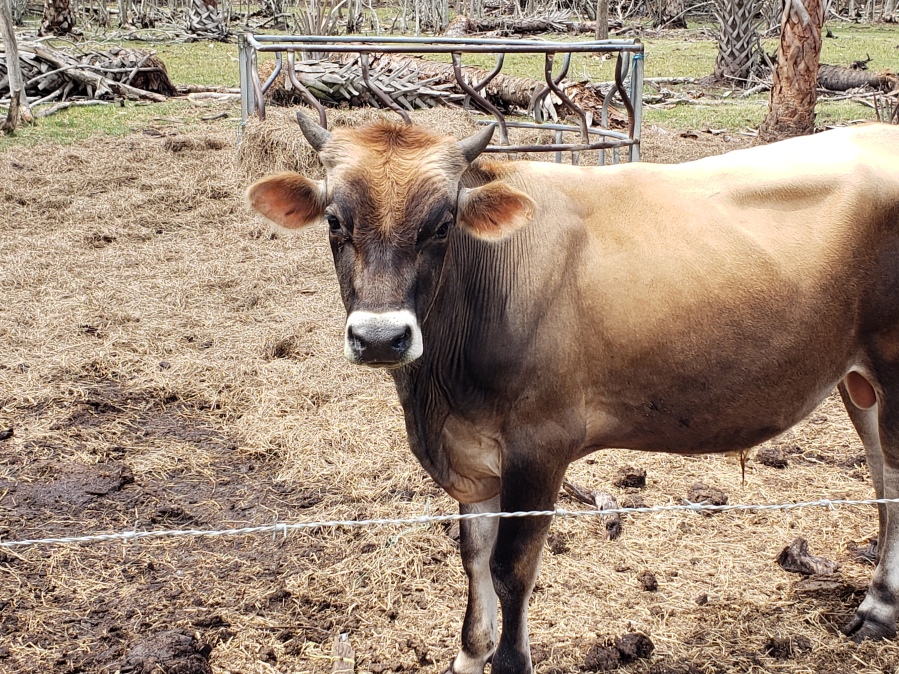Let’s talk about horns! Whether or not to leave cows with their horns is one of those hotly debated topics; not just amongst producers and animal rights activists, but amongst cattle breeders themselves. We choose to dehorn our animals and try to do so in the most humane way, so let’s look at some facts about horns and how we handle them.
Just the Facts
All cattle, unless they are born polled (meaning they have a gene that prevents the growth of horn cells, i.e. they will never grow horns) will have horns. Yes, females too. You can’t assume that a bovine is a bull because it has horns. Some breeds, such as the Angus, are all naturally polled. Horns in cattle have a core of live bone with an outer covering of keratin (the stuff that hooves and hair are made out of too) and other proteins. Check out the picture below of when the outer covering of Poppy’s horn got knocked off. Unlike antlers, as horns start to grow they will fuse to the skull and become permanent projections from the head. This is why, if you are going to dehorn a calf, it’s imperative to do it as young as possible before that attachment happens.

Horns serve several purposes, the most obvious reason being to fight off predators. Horns can determine dominance in a herd and can also act as a place for the animal to release heat. For some cattle breeds such as the Jersey, Ayrshire and Texas Longhorn, horns were, or still are, an important trait or hallmark of the breed.
Why Dehorn?
The biggest reason is safety. Just like having an aggressive live bull on property, having an animal with horns can be extremely dangerous, even if unintentionally. Not only can an animal with horns hurt its handlers, they can damage property, injure or kill other livestock or even themselves, even just by being playful. As a prime example, I had a goat with horns when I was in high school. She was always getting her head stuck in the fence, no matter what we did to prevent it. She wasn’t the brightest animal around. She met her end when one day her horns got stuck in the fence again, and she ended up strangling herself. 😦
Another reason we choose to dehorn is because most of our cattle are shown at the fair. Most shows have a requirement in their rules that the cattle must be dehorned or that the horns must be less than 2 inches long. If we don’t dehorn them, they can’t be shown.

How is It Done?
I’m not going to lie; dehorning an animal without pain relief or some sort of numbing is extremely painful. I always compared it to cutting off the tip of my finger and then burning it with an iron. This is one of the reasons that activists have such a problem with the practice and personally, it was always one of those things I hated doing until I learned how to numb them. If done correctly and early though, it can be done with little to no discomfort to the animal.
The most humane thing to do, is to give a nerve block. We give 5 cc of lidocaine into each side of the head before dehorning. If given correctly and given enough time to take effect, the calf shouldn’t feel anything and will just stand there. We also give a long acting pain reliever like Banamine, so that after the lidocaine wears off they still have some pain relief.
After numbing, we burn the horn bud with a propane/butane dehorner, which was honestly one of the best tools I’ve ever bought. It’s light, heats up in no time, has no cord to get in the way, and once healed, leaves the calf looking like they never had horns at all. Once we’ve burned the bud, we’ll spray it with a wound spray and keep an eye on it for the next couple of weeks until the scab comes off and it’s healed. It’s important to keep flies off of it and watch for infection. We very rarely have any issues with dehorning following this procedure.

There are several other methods of removing the horns, including:
- Caustic pastes that will remove the tissue, but you have to do this when they are very young and make sure the paste doesn’t get on any other tissues other than the horn bud. I learned that lesson the hard way…
- Scoops, where the tissue is literally just cut off, but if not also cauterized, the horns will usually grow back.
- Bands. In cattle that have bigger horns, some people will use a castration band placed on the base of the horn, to cut blood flow to the horn and it will eventually fall off on its own.

Seeing as that dehorning is one of those often questioned practices, more breeders are moving to using polled genetics in their herds, to avoid having to dehorn at all. This is another advantage to using artificial insemination as there are more bulls becoming available that carry the polled genes. I can’t ever see a day in my lifetime where ALL cattle will be naturally polled, so there are always going to be ones that need to be dehorned. With advancements in tools and access to pain relief (not too mention that lidocaine is SUPER inexpensive… it costs less than a dollar per calf for the dosage needed), there’s no reason why we can’t ensure that dehorning causes as little discomfort to the animal as possible. Sure, horns are cool looking, even pretty some say, but they aren’t worth the safety risks of leaving them intact on a domesticated animal. If you have a question about dehorning, or any other husbandry practice, leave a comment below or send us a message!

